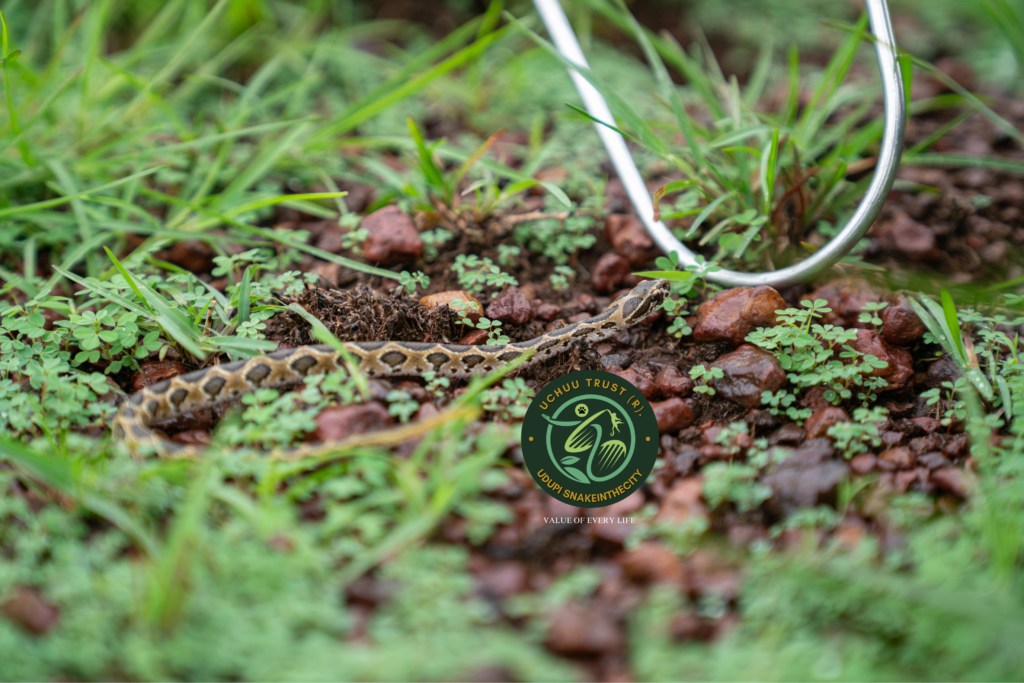VENOMOUS
- Description: This snake is responsible for more snakebite deaths in India than any other species. It has a distinctive chain-like pattern on its body and can grow up to 5.5 feet in length. Its venom is hemotoxic, causing pain, swelling, and blood clotting disorders.
- Habitat: Grasslands, open fields, and agricultural areas in South and Southeast Asia.





Scientific Classification
- Scientific Name: Daboia russelii
- Family: Viperidae
- Genus: Daboia
Physical Description
- Size: Adults typically range from 1 to 1.5 meters (3.3 to 5 feet) in length, though some individuals may exceed 1.7 meters (5.6 feet).
- Color: It has a tan or brownish body with large, dark brown or black, oval or circular spots bordered with white or yellow, running down the back and sides.
- Head: The head is distinctly triangular with a V-shaped or arrowhead mark on top, and the eyes are large with vertical pupils.
- Scales: The body is covered with keeled scales, giving it a rough texture.
Behavior and Ecology
- Habitat: Found across the Indian subcontinent, including India, Sri Lanka, Bangladesh, Nepal, Bhutan, Myanmar, and parts of Southeast Asia. Prefers grasslands, open plains, agricultural fields, scrub forests, and often near human habitations.
- Activity: Primarily nocturnal but may be active during cooler parts of the day.
- Behavior: Highly irritable and aggressive when threatened. They are quick to strike and have a loud, distinctive hiss. It often coils its body in an S-shape when provoked.
- Diet: Feeds on rodents, lizards, birds, and other small mammals, playing a crucial role in controlling rodent populations.
Venom and Medical Significance
- Venom: Hemotoxic venom that affects blood and tissue, leading to blood clotting issues, tissue damage, and internal bleeding. The venom is potent and can cause severe pain, swelling, and systemic complications.
- Symptoms of Bite: Pain, swelling, bleeding, bruising, blistering, blood clotting abnormalities, kidney failure, and in severe cases, death.
- Treatment: Immediate medical intervention is required with antivenom being the primary treatment. Supportive care for complications such as kidney failure may be necessary.
Reproduction
- Breeding Season: Typically during cooler months.
- Reproduction Type: Ovoviviparous (gives birth to live young).
- Clutch Size: Can give birth to 20-40 live young at a time, sometimes even more, making it one of the highly reproductive species among vipers.
Conservation Status
- IUCN Status: Least Concern, but local populations may be threatened by habitat loss, hunting, and road mortality.
- Threats: Habitat destruction, human persecution due to fear, and accidental killings.
Cultural Significance
- Russell’s Viper is often feared due to its aggressive nature and high involvement in human snakebite incidents. It is one of the “big four” snakes responsible for the majority of snakebite deaths in India.
Interesting Facts
- Namesake: Named after Patrick Russell, a Scottish herpetologist who first described the species.
- Hissing: Known for its loud, high-pitched hiss that serves as a warning to potential threats.
- Venom Yield: Known to produce a high yield of venom compared to many other venomous snakes.
Safety Tips
- Avoidance: Be cautious in grasslands, agricultural fields, and areas known to be inhabited by Russell’s Vipers.
- Stay Calm: If encountered, remain calm and slowly back away. Do not attempt to handle or provoke the snake.
- First Aid: In case of a bite, immobilize the affected limb, avoid movement, and seek immediate medical attention. Do not attempt traditional remedies, and rush to a hospital with antivenom availability.
Role in the Ecosystem
Russell’s Viper plays a crucial ecological role by regulating rodent populations, which helps in pest control and reduces the spread of diseases associated with rodents. Understanding and respecting this snake can help minimize human-snake conflicts while highlighting its importance in maintaining ecological balance.







